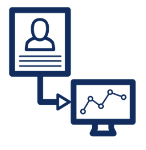Auto Insurance Shopping Trends
After a few tough years, 2023 looks like it will be a better year for insurance companies. As inflation finally begins to cool, auto insurance shopping trends are up and carriers are aggressively filing for rate hikes to offset increased losses realized in recent years. On average, auto insurance rates went up by 4.9% across the country in 2022, affecting roughly 62.5 million policyholders. And while this is good news for carriers, consumers better buckle up because 2023 is looking to be even worse with an estimated 8.4% hike.
That said, it’s not all upside for carriers. As inflation continues to run rampant across virtually every spending category, consumers are more price-conscious than ever. And what do you think the average customer does when faced with a significant price hike?
They shop around – creating a once-in-a-decade opportunity for forward-thinking carriers.
In our view, 2023 isn’t just the Year of Real-Time Intent Data, it’s the Year of “The Great Shop.”
Why are auto insurance rates rising?
Simply put, the cost to insure a vehicle today is significantly higher than it was a few years ago. We’ve seen the perfect confluence of events – supply chain disruptions, rampant inflation, more car crashes, increased labor costs, and more expensive cars and car parts, all of which combined to create a brutal environment for carriers and customers alike.
Inflation = Higher Prices
Everywhere you turn, you’re confronted with the dreaded “I-word.” Whether you’re at the grocery store, the airport, or the gas station, there is no avoiding inflation these days. With year-over-year CPI clocking in at a whopping 9.1%, inflation is driving up costs at every level of the value chain.
For consumers, 2022 was a brutal year to purchase a vehicle. New car prices were up 10.8%, interest rates were the highest in 15+ years, and the cost to insure your vehicle was higher than ever. With that, many consumers turned to the used car market for a little respite, only to find that used car prices were sometimes more expensive than new cars! From February 2020 to September 2022, average used car prices were up 42.5%. 🤯 While we have seen some moderation in used car pricing, it remains elevated.
More Crashes = More Claims
Claims and profits tend to be inversely proportional. When claims are high, profits are low, and vice versa. Well, in 2022, we saw the fourth consecutive quarter of increasing traffic accidents, injuries, and fatalities, according to Triple-I, which killed profit margins across the board for auto carriers.
The math is simple – increased accidents mean more claims and lawsuits, which means higher insurance payouts and higher consumer premiums. Add in the fact that cars themselves are much more complicated today than they were in the past, so even small accidents can have huge costs as the electronic systems require specialized repairs. Oh yeah, I forgot to mention that the rare metals and electronics used to build these systems are ripe targets for thieves.
Unfortunately, the price hikes don’t stop there. Healthcare costs are also on the rise, meaning claim payouts in the event of an injury are even more expensive.
Broken Supply Chain = More Expensive Parts
In 2022, it was estimated that car parts were, on average, 7-20% more expensive. According to the Department of Labor, vehicle parts and equipment are up 14.9% across the U.S. from last year with car maintenance and repair seeing its most significant increase since 1974.
There are many reasons for this – inflated material costs, reduced workforces from COVID, the Suez Canal incident, a global “chip” shortage, higher fuel costs, and a break in the “just-in-time” inventory management system made popular by globalization over the past few decades, to name a few. And once those parts finally arrived, you were lucky if there was someone there to fix your vehicle…
Labor Shortages = Higher Wages
Despite the constant drumbeat of recession warnings, the job market is still thriving. Unemployment is hovering right around where it was pre-pandemic, making it difficult for companies to find workers. The “Great Resignation” in 2022 pushed many workers out of the job market or onto different career paths. This leads to increased wages and lower productivity, again leading to higher auto insurance rates.
“The Great Shop” is creating a once-in-a-decade opportunity
If you Google, “How do I lower my car insurance premium?” You will almost certainly find the most popular answer to be “shop around.” Auto insurance shopping trends are up significantly this year and we expect this trend to continue.
Our guess is that in 2023 we will see a record number of people changing carriers.
Price hikes hurt, tempting even your most loyal customers to test the waters. While average retention rates are significantly lower among non-bundlers (85%) than bundlers (95%), even 31% of bundlers say they “definitely will” switch their home insurer if they switch their auto insurer after an auto premium increase. This is not good for carriers given that bundlers are the holy grail when it comes to desired customers, and we’re already starting to see the impact. Travelers stated their retention rate for personal auto insurance dropped to 82%, 4 percent below what it was a year ago.
Like many other industries, insurance customers quickly sacrifice loyalty for lower auto insurance rates. And, unfortunately, your competitors are especially interested in your best customers, who have been loyal for many years and have few claims. But while they may end up shopping around, your competitors’ best customers will also be shopping around.
With auto insurance shopping trends up – herein lies the once-in-a-decade opportunity…
How to Take Advantage of “The Great Shop”
Carriers spend an incredible amount of money to attract potential customers. The top 4 auto carriers spent over $6B on marketing alone in 2021. The challenge is that they don’t know much, if anything, about the purchase intent of the users they attract. Are they window shopping or are they motivated buyers? Would a discount persuade them, or would they purchase a policy regardless? Are they more likely to buy online or over the phone?
Unfortunately, without this type of information, carriers waste millions of dollars giving out discounts to people who didn’t need them, spend valuable time and money calling applicants who would have converted anyway, or worse, waste precious time calling applicants who never had any intention of buying, to begin with.
The wasteful spending on non-buyers raises the total cost of acquisition (CAC) significantly and hurts lifetime value (LTV).
But what if you knew their purchase intent while they were filling out your application? And, better yet, what if you had the ability to react to those users in real-time while they were filling it out? Imagine how much better your digital experiences could be if you could dynamically adapt them to each person who used them. When you’re selling face-to-face, you intuitively read and react to the person sitting in front of you. What if you had the ability to do that – online?
It’s not science fiction; it’s Behavioral Data Science. With real-time intent scoring, carriers have the unprecedented ability to read and react to their applicants’ digital body language in real-time and drive the next-best-action for each applicant.
- As Manny is filling out his application, you’re alerted that he’s a high-intent shopper so you call your 3rd party checks earlier in the process so he sees the correct quote at the time of purchase.
- As Tom finishes his quote, you’re alerted he’s a low-intent shopper so you add a discount, but deprioritize him on the call queue.
- As Larry gets to the third page of the quoting process you are alerted that he’s a “Persuadable” and you’ve got a better chance of closing him in the call center so you nudge him toward a dedicated phone number.
- As Sally gets stuck on a question and shows signs of confusion, you offer her contextual help or drive her to a call center, recreating a similar experience to that of an in-person interaction.
After years of pervasive “grow-at-all-cost” mentalities, profitability is back in vogue. With ForMotiv’s Growth Solutions, leading carriers can finally understand user intent. With this newfound intelligence, they can dramatically improve user experiences, increase conversion rates, and drive profitable growth. Oh, and they can do it while reducing risk and premium leakage.
And as “The Great Shop” continues over the next few months, carriers will be playing a game of “Hungry Hungry Hippos” as they scramble to acquire as many of them as they can.
Those with ForMotiv have a distinct advantage.
In conclusion, auto insurance rates are rising, creating an opportunity for forward-thinking carriers…
As customers inevitably begin poking around for new deals and better auto insurance rates, understanding their purchase intent is one of the single most important data points you can have on them. “The Great Shop” is creating an excellent opportunity for you to find the next cohort of high-intent, high-lifetime-value customers who will stay with you for the next decade or more. And only ForMotiv has the ability to predict purchase intent and provide next-generation digital experiences that help customers convert at the right time and place.
You spend more than enough money attracting users to your site, it’s crucial that you provide the best experience possible and convert them while they are there. ForMotiv makes this possible by providing a variety of real-time intent scores and driving the next-best-action both in real-time and offline.
If you’re curious to see what we’re doing with some of the largest P&C carriers in the world, please schedule some time to chat with us.





